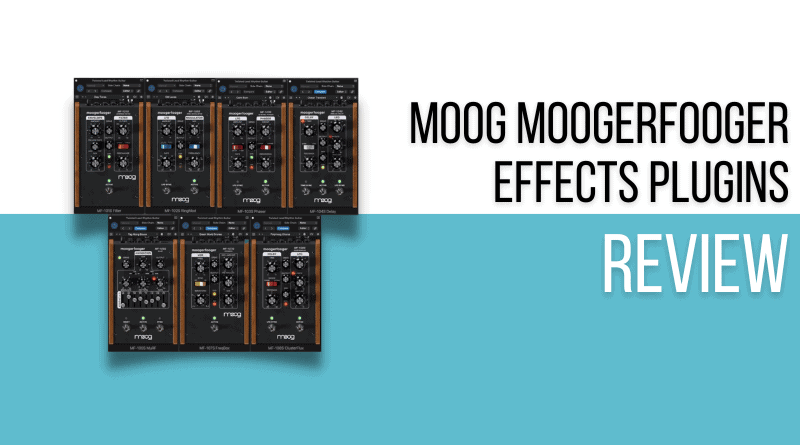Moog’s “Moogerfooger” line of analog effects pedals originally launched in 1998 with the MF-101 low-pass filter, and went on to include six more pedals, all huge hits with pedal fiends, particularly users of modular synths which made tidy use of the pedals control voltage compatible hardware.
Then in 2018, Moog discontinued the pedals, and suddenly they were selling for big bucks on the used market – and for good reason. Each pedal was a market leader in terms of sound and overall functionality, making them “must have” pedals for many.
Even before the Moogerfooger pedals were discontinued, Moog had been releasing digital versions of fan favorites such as the Model 15 in 2016 and the Model D in 2018, so of course fans have long been calling for a digital version of the Moogerfooger line, and now we have it – the seven original pedals in AU/AAX/VST3 formats, sold as the Moog Moogerfooger Effects Plug-Ins Bundle.
Now, much has been made online of how these pedals sound for synths and basses, but there isn’t much as far as how they sound with guitar, so we spoke to Sweetwater who provided the suite of plugins for us to test. As ever, Sweetwater provided no directions or talking points and sought no signoff, so all thoughts and opinions in this review are solely from the team at KGR.
For this KillerGuitarRigs review, we loaded the pedals into Cubase and played a Fender Jaguar into a Kemper running into the computer through a Universal Audio Volt 2 interface.
Can these plugins provide the same class leading sounds as the pedals – and do they have a place in a guitarist’s arsenal? Let’s find out.
Read more about our review process.
Contents
Moog Moogerfooger Effects Plugins: Who Are These For?
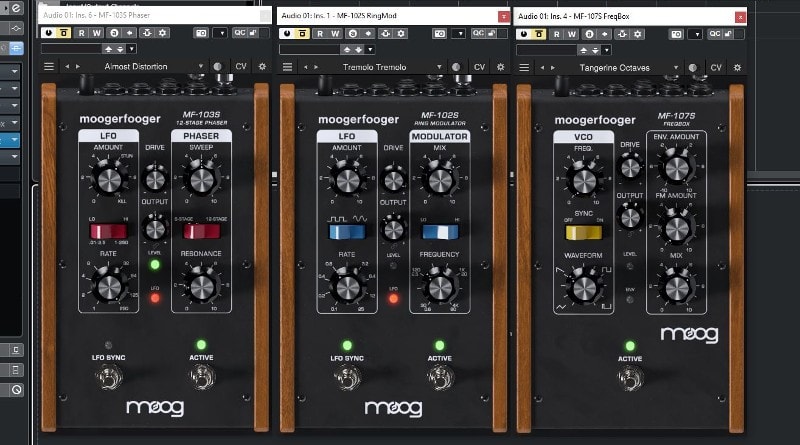
The Moogerfooger plugins are perfect for anyone who uses amp sims for their guitar tones, and wants more organic and distinctive modulation/delay/filter options than they would otherwise get inside something that focuses more on nailing an amp tone.
If you get most of your tone from something like the Neural DSP Archetype series, the plugin bundle offers a perfect complement to add some more seasoning to your tone for both clean and broken up passages.
Format wise, the seven plugins come as AU, AAX and VST3 plugins, but not as standalone apps, so you will need a DAW to operate.
The Dirty 7
The Moogerfooger bundle comprises 7 plugins/pedals in total:
- MF-101S – Lowpass Filter
- MF-102S – Ringmod
- MF-103S – Phaser
- MF-104S – Delay
- MF-105S – MuRF
- MF-107S – FREQBOX
- MF-108S – Clusterflux
Appearance / Features / Controls
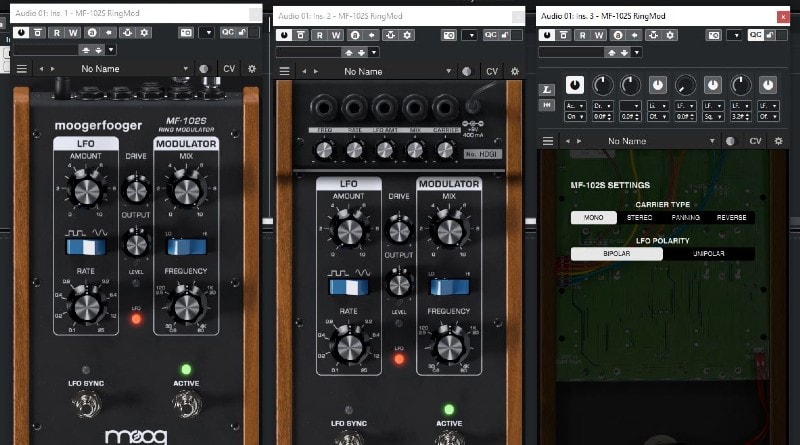
For the most part, the plugins have been designed to look and operate exactly as the original pedals did, so if you were an owner before, you know exactly how to get back to the sounds you love – but even if you’ve never used them, the controls are quite intuitive.
Each plugin’s default view has a line of controls across the top for things like automation, side chain routing, and quickly switching between saved settings. Below that is a drop down for the various factory presets, and then the meat of the pedal, which provides all of the main controls, as well as drive and output settings, and at the bottom footswitches to complete the look.
You can also activate several hidden control panels – the VST quick controls, which give you all of the controls from the main pedal but in a more concise format, a replica of the rear panel controls which give you additional CV routing options, and an additional panel with pedal specific controls that allow adjustments to things like carrier type or LFO polarity.
One drawback of the plugins is that you cannot resize them, so loading up several at once on a small screen can become cumbersome – somewhat frustrating when the pedals play so well together, and stacking them can provide some real magic.
Performance / Sound
As you would expect, the pedals all sound amazing – once you get them dialed in for a guitarist. In most cases, we were able to get some killer modulations and effects from the pedals within a minute or two of loading them up, and the addition of the drive control to the pedal gives them a nice touch of analog grit.
Each pedal comes with a menu of presets that provide a range of sounds from minor adjustments to your signal to huge, overpowering modulations – it’s obvious that the pedals were made with synth users in mind, but for guitarist there are still some presets that shine a light on what the pedals are capable of.
Again the real magic comes from exploring with the pedals – for example, putting the 102s Ring Mod pedal into the 1936 Computer preset sounds like what you’d expect, but rolling off the amount and rate controls of the LFO, and then switching the modulator to low and frequency to 120 leaves you with an amazing tremolo sound with just enough grit to make a broken up tone sound like it’s in the desert.
On top of that, you can switch the carrier type from mono to stereo, or to a panning control that gives an amazing effect whereby the left and right channels modulate in and out of phase, with reverse doing the same in the opposite direction.
The great thing is that almost every pedal has these amazing “ah ha” moments available with a little tweaking, allowing you to get lost in tinkering fast, and come up with a ton of usable tones.
Our Favorites
There’s a lot of sounds on offer within this bundle, but off the top our favorite plugins and presets were:
MF-102S – Ringmod
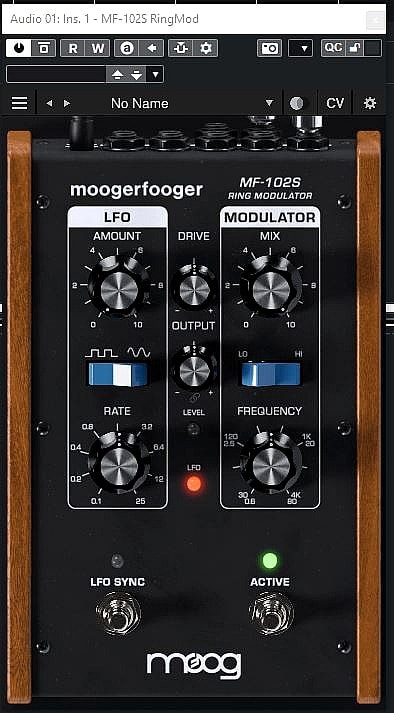
The Ringmod combines an LFO with a ring modulator, with additional controls for drive and output, and footswitches for LFO sync as well as engaging/disengaging the pedal.
This was easily our favorite, with enough controls to allow you to quickly dial in a variety of amazing tremolo tones and manipulate them with the LFO.
It’s almost impossible to pick one or two of the best presets, but we really enjoyed Slow Leslie, Reverse Logic, and Old Lanes, with runners up being Flutter Butter, Penumbra Plane, Radio Talk, Stereo Widener, and any of the Tremolo presets.
MF-104S – Delay

This one combines an LFO with a delay, with drive/output/mix controls, and three footswitches – time sync, LFO Sync, and engage or disengage the pedal.
This pedal had a ton of pleasant surprises that you wouldn’t expect from a delay – courtesy of the LFO. On top of some amazing delays, such as the Astral Chorus preset that gives you a deep space vibe with trails that ascend and descend, and the Soul Poet Slapback that’s exactly what you’d expect, the Hugh’s Chorus preset actually gives you an amazing 80s chorus sound and Ocean’s Transient puts you in deep space with a background chorus of whale sounds (if you can imagine it).
Overall, it’s a really cool pedal that gives you a ton of great sounding delays along with the option to dial in some amazing twists.
MF-103S – Phaser
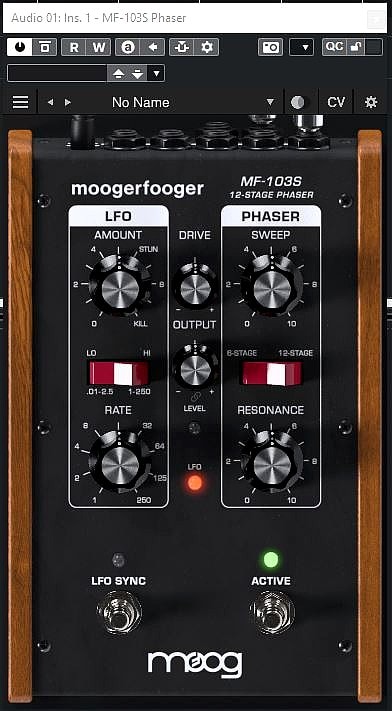
The MF103S combines an LFO with a 12-stage phaser, with additional controls for drive and output, and footswitches for LFO sync as well as engaging/disengaging the pedal.
Again some really awesome sounds here, from the Fender Rhodes Phaser (not just for pianos – this sounds great on guitar), to the Almost Distortion preset that’s exactly what you’d expect. Additionally, the ability to switch the stages of the phaser as well as apply a variety of LFO sizes makes this a really versatile phaser.
Other Plugins
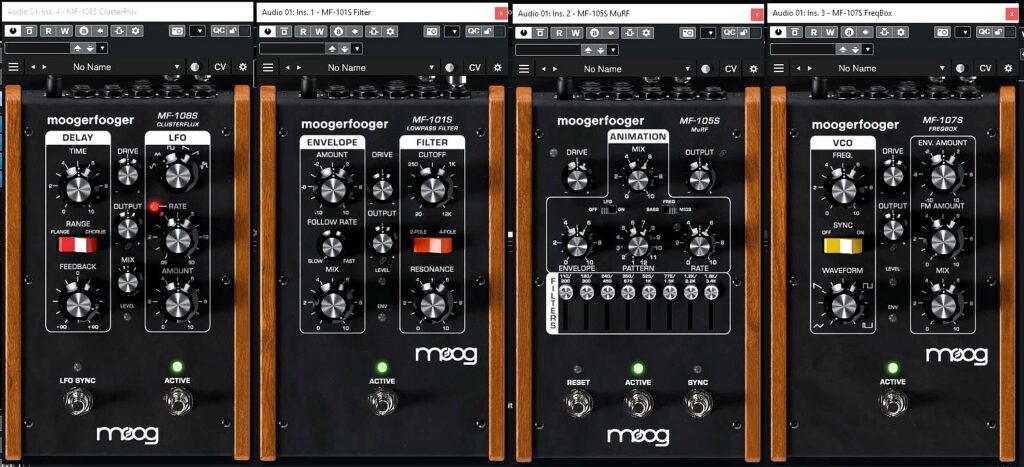
While the 102/103/104 were our top choices, if you have a penchant for funk or soul, there is a lot to work with in the MF-101S – Lowpass Filter, and the MF-108S – Clusterflux combines a delay and LFO in such a way that you get a ton of really interesting flanger and chorus sounds, along with a wide variety of other options once you play around with it.
Final Thoughts on the Moogerflooger plugin bundle
The Moogerflooger plugin bundle, like the pedals that it emulates, provides a wide range of best-in-class sounds for anyone looking to add some interesting modulations, delays, filters and more to their digital toolbox.
While the bundle seems to be largely marketed at synth users, there’s a lot here for guitarists, and you can get incredibly organic sounds out of each of these pedals.
If your guitar tone arsenal is made up largely of amp sims like Amplitube, Guitar Rig or any of the Neural DSP Archetype series, this plugin bundle is an essential, no-brainer purchase to complement and expand the range of tones at your disposal.
If you do decide to pick it up, check our favorite retailer Sweetwater, who at the time of our review were offering a sizable discount off the regular price.

